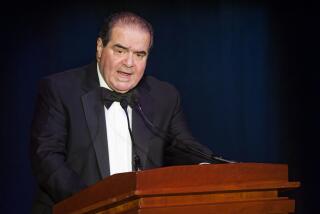Judge and Jurist : Supreme Court opinions that continue to shape the present : HUGO BLACK: A Biography, <i> by Roger K. Newman (Pantheon Books: $30; 741 pp.)</i>
On a Mt. Rushmore of Supreme Court greats, the stubborn, mesmerizing face of Hugo Black would be chiseled next to those of John Marshall, Oliver Wendell Holmes Jr. and one or two other justices. In a career spanning 34 years, from 1937 until 1971, he issued gallant opinions that made the Bill of Rights a brawny protector of individual liberty.
âFreedom to speak and write about public questions,â Black wrote, âis the heart of our government.â He translated the First Amendmentâs defense of that freedom into a rousing instrument of democracy, âwithout any âifsâ or âbutsâ or âwhereas.â â He also reconstructed the amendmentâs religious guarantees into a wall between church and state. A generation after his death, Blackâs influence has recently been apparent once again. It is a 32-year-old landmark opinion by him explaining why the Supreme Court found organized school prayer âwholly inconsistentâ with the Constitution that makes it necessary for the country to amend its fundamental law if such prayer is to be legal in public schools.
Black was also a son of Alabamaâs hill country, who owed his 1926 election to the U.S. Senate to his membership in and persistent courtship of the Ku Klux Klan. To Franklin Roosevelt, who picked him for the Court, to Senate colleagues who confirmed him quickly, to 40 million Americans who turned on their radios to hear him explain this tie after it was exposed by the Pittsburgh Post-Gazette, and apparently to himself, Black never faced up to the epic contradiction of using that odious base as a springboard to a career as a liberal populist.
Roger K. Newmanâs âHugo Blackâ is the first comprehensive biography of the illustrious, dodgy, fascinating jurist. For Supreme Court scholars, legal librarians and avid students of Southern politics and constitutional law, itâs a thick compilation of anecdotal material worth owning. Newman had access to the justiceâs family, his one-time law clerks, and others in his circle, and he took profuse advantage of it. Newmanâs enthusiasm and sustained commitment were colossal: he started his research in 1968 and, he says, worked on the book full time from 1982 until it was done. The source notes alone fill 75 pages of the 741-page volume and mark his relish for research. Newman even combed through Blackâs library, to cull marginalia from the justiceâs favorite titles.
But the bookâs failings are dumbfounding. For an author privileged to have support from major foundations and from New York University Law School as a research scholar, they raise the question: Who has the responsibility for quality control? In the acknowledgments, Newman thanks many estimable supporters but doesnât mention an editor. He desperately needed one. Instead of a biography, âHugo Blackâ is more like a research file awaiting serious shaping: Itâs sprawling, often undiscriminating, and stuffed with irritating digressions; itâs riddled with sections that bury the point and cliched sentences that donât have any. In the debate whether computers improve or undermine the quality of books, Newmanâs brick topples the scale to the negative.
One theory about Newmanâs problem as a biographer is that he got so close to his subject that he couldnât judge him and so did everything but. In Newmanâs epilogue, smugly called âOf Hugo and Me,â he dubs the project his âobsessionâ and boasts about coming up with the idea of a stamp honoring the centennial of Blackâs birth in 1986 and about drafting the congressional law making that Hugo Black Day. Such promotional activity seems antithetical to the role of an independent biographer, which is how Newman presents himself.
Another theory is that, whatever his role, Newman lacked the capacity to explain Black coherently in a narrative biography. The best evidence to support this thought are tone-deaf Newman sentences that leave the impression of a gushing, simplistic viewpoint: âThe ancient world spoke to him (Black) as if it were breathing.â âBlack and books, and books and Black--they went together like Black and tennis.â Justice William O. Douglas and âBlack had a truly brotherly relationship (if one hiccuped, the other would practically say âexcuse meâ).â âLife at the Court is like a turtle--it moves slowly and quietly.â
The tragedy of Newmanâs botched behemoth is that it smothers three wonderful, important stories. The first is a portrait of Black the populist. Hyperactive and opportunistic, sarcastic, self-righteous and sentimental, he was a peopleâs lawyer who made his mark representing workers in personal injury suits against big corporations. His ambition alone was a force to be reckoned with and, igniting his talent, made him a player in every arena he entered. Even on the Supreme Court, he entertained the notion of running for president.
The next is the transformation of Black into a Supreme Court titan through an accident of fate, strong will and combat with a series of outstanding justices. Because of his advocacy of Rooseveltâs plan to pack the Supreme Court, Black was picked after the expected nominee dropped dead. He turned himself from a dismal draftsman whose early opinions raised questions about his fitness for the job (âTheyâre not even acceptable by law school standards,â Justice Harlan Stone commented) into an eloquent writer. He triumphed in famous feuds about legal ideas, notably with Justices Robert Jackson and Felix Frankfurter.
Finally comes the tale of Blackâs jurisprudence, which makes clear how any justiceâs legal ideas are heavily shaped by history. Black came to the court when it was dominated by conservatives who stymied Rooseveltâs program of recovery from the Great Depression. They did so by striking down New Deal laws that Black favored as a senator. To buttress his belief in limited judicial review, he developed the idea that the court should enforce only the plain meaning of the Constitution. Until the end of his life, when his decisions become cranky, Black often read that document expansively. Today, however, when conservatives speak about retrenchment in constitutional law--about correcting liberal mistakes of the Warren and Burger courts for which Black laid the groundwork--they use language similar to his to reach the opposite conclusions.
Attention, Hollywood readers: A patient, resourceful writer will find in Newmanâs research the makings of a sweeping, eye-opening movie about an American original. Hugo Black contains the raw material for a dramatic, affecting and insightful work: from Blackâs attendance at court sessions in his hometown beginning at the age 6, to his role as a Ku Klux Klan officer initiating new members of his Klavern; from his refusal to acknowledge his first wifeâs suicide after years of depression, to his daily injection of himself with testosterone after he married his secretary when he was 71 and she was 49; and from his naive start on the court when he met most of his colleagues in the robing room before first taking the bench, to his vain quest to break the record for longevity as a justice, which led him to end his tenure as a fulminating has-been.
This year, in Gerald Guntherâs fine biography of Learned Hand, readers have been blessed with an example of a thoroughly researched work that shows what can be done with similar riches. It explains the judgeâs writings in the context of his life and offers an animated profile drawing on all relevant personal, political and legal history. The Gunther volume underscores what Newmanâs lacks. âHugo Blackâ is a biography waiting to be released from the curse of comprehensiveness.
More to Read
Sign up for our Book Club newsletter
Get the latest news, events and more from the Los Angeles Times Book Club, and help us get L.A. reading and talking.
You may occasionally receive promotional content from the Los Angeles Times.








